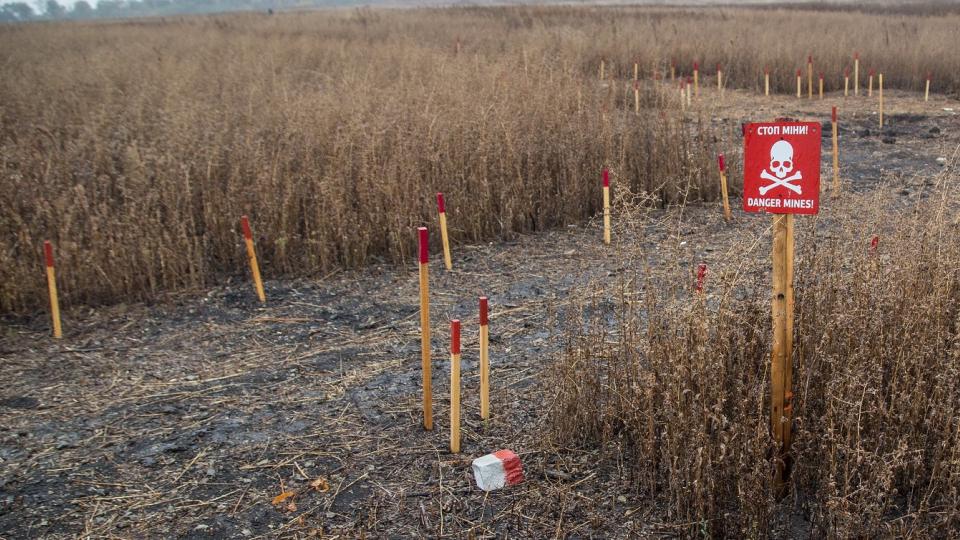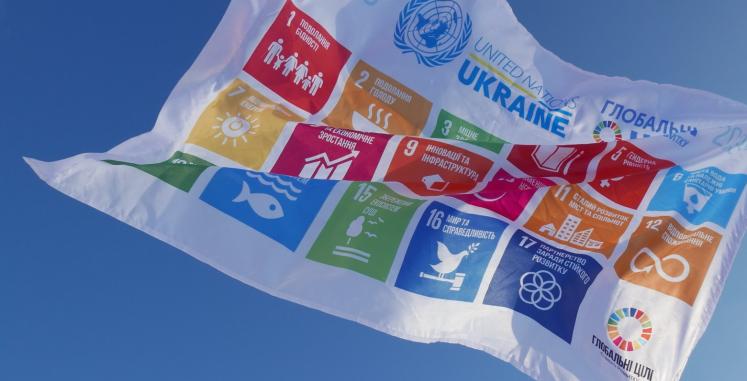
The UN Sustainable Development Goal (SDG) 16 – encompassing peace, justice, and strong institutions – happens to sit at the bottom of the list of the SDGs, and can therefore sometimes be seen as less important or crucial than some of the other goals. However, I can say from my personal background that experiencing war in one's native country results in a completely different perspective on the world and current global development efforts.
24 February 2024 marked the second anniversary of Russia’s full-scale invasion of Ukraine. This unprovoked military aggression has become the largest humanitarian crisis in Europe since the conclusion of World War II, ranking as the world’s deadliest conflict in the first half of 2023. Although active conflict has been happening only in one country, this war has had global implications, taking a toll on all of the SDGs and affecting the everyday lives of people around the globe. Here, I share an analysis of how the conflict has influenced – and continues to influence – progress toward achieving the SDGs.
SDG 1 – No Poverty
In 2021, before the invasion, the World Bank estimated that the proportion of Ukrainians living in poverty was 5.5%, with statistics over the previous years showing a gradual decrease in this measure. The war has set back 15 years of progress, pushing an additional 7.1 million more people into poverty and raising the poverty rate to 24.1% in 2022. Among the key factors driving poverty in the country are loss of livelihoods, economic decline, increased costs, forced displacement, and vulnerability.
Apart from the immense negative consequences on the national level, the war led to disruptions in trade and supply chains, as well as rising energy prices. Altogether, these factors threaten extreme poverty for millions of people, disproportionally impacting vulnerable states and regions.
SDG 2 – No Hunger, SDG 15 – Life on Land
The invasion, followed by active conflict, resulted in massive damage to infrastructure, including the destruction of 25,000 km of roads, as well as supermarkets and warehouses. Millions of people found themselves cut off from routes that previously ensured the supply of key products. The UN Office for the Coordination of Humanitarian Affairs (OCHA) estimates that 14,6 million Ukrainians (40% of the population) will need humanitarian aid, including food provision, over the course of 2024. Furthermore, Ukraine has surpassed Afghanistan and Syria to become the most heavily landmined country globally. Approximately 25,000 square kilometers of agricultural land are potentially littered with landmines and other hazardous debris from the war, resulting in hundreds of deaths and injuries.
Nowadays, almost 60% of the world's most hungry people live in conflict-affected areas. The shockwaves of the war in Ukraine were felt around the world, and the invasion has led to the most substantial rise in global food insecurity due to military actions in at least a century. According to the Food and Agriculture Organization of the UN (FAO) Report on the State of Food Security and Nutrition in the World, due to the war in Ukraine, the projected number of individuals who will confront hunger in 2030 will increase by 23 million.
SDG 3 – Good Health and Well-Being
By May 2023, the World Health Organization (WHO) recorded more than 1000 attacks on healthcare workers and facilities in Ukraine. Apart from the implications on the physical health of the civilian population, Ukrainians have reported the detrimental impact of the war on their mental well-being. The Ukrainian Minister of Health estimated that 14 million citizens need psychological aid, and according to UNICEF data, approximately 1.5 million children in Ukraine are dealing with war trauma and are at risk of depression, anxiety, post-traumatic stress disorder, and other mental health issues.
The negative impact of military actions in Ukraine, which led to a surge in uncertainty around the world, affected individuals' well-being and mental health on a global scale. Some studies demonstrate an increased number of individuals in Europe reporting anxiety and stress due to rising living costs, as well as exposure to images depicting violence.
SDG 4 – Quality Education
The invasion has had numerous short- and long-term consequences for the education of Ukrainian children and youth, as well as the country’s human capital. As of November 2023, over 3,790 educational facilities have been damaged or destroyed. Thousands of teachers were displaced or fled the country. Millions of children have to constantly deal with air-raid alarms, spending months studying in bomb shelters. Such conditions, paired with mental issues, significantly affect their academic achievements. This could eventually affect other SDGs, leading to a setback in fighting poverty and inequality.
The war also has implications for neighboring countries that welcomed Ukrainian refugees, since there is an additional strain on their education systems.
SDG 5 – Gender Equality
The women and girls in Ukraine are enduring significant consequences of the war, ranging from increased trafficking and gender-based violence to the loss of vital sources of income and the escalation of poverty. With widespread infrastructure damage, survivor services, healthcare (including sexual and reproductive), and essential support systems have become inaccessible for many. Ukrainian authorities also recorded numerous reports of women who became victims of sexual violence under Russian occupation.
SDG 6 – Clean Water and Sanitation, SDG 14 – Life Below Water
Widespread damage has been caused to the country’s water supply: bombardments have targeted and destroyed water treatment facilities, pumping stations, and distribution networks, resulting in severe disruptions to water access for 4.6 million people. Furthermore, the conflict has raised concerns about water contamination. Fighting and shelling have polluted water sources with explosives, heavy metals, and other hazardous substances, rendering them unsafe for consumption. Sunken military ships and aircraft that carry oil are also a source of pollution in the Azov and Black Sea that affects marine life.
SDG 7 – Affordable and Clean Energy, SDG 11 – Sustainable Cities and Communities
Ukraine's energy infrastructure has also been adversely affected, with damage to its power plants, transmission lines, and renewable energy facilities. Consequently, power outages, energy shortages, and disruptions to clean energy initiatives have ensued. Having been left without electricity and therefore without running water and working kitchens (modern buildings are usually equipped with electric stoves), communities were forced to use diesel-powered generators. Beyond this, many cities where active conflict took place were reduced to a pile of rubble. Millions of people had to flee, resulting in brain drain. The latest update from the World Bank estimates the price of rebuilding Ukraine at $486 billion. The rebuilding would also require comprehensive policies to encourage citizens to return.
Moreover, global energy market disruptions have resulted in notable spikes in oil, gas, and coal prices, making all energy sources less affordable and impeding access to clean energy alternatives in certain regions. However, in this regard, the war also had a somewhat positive impact on a global scale, since developed countries were forced to rethink their reliance on Russian oil and gas and increase investment in green and sustainable energy and practices.
![A woman stands near her damaged house in the village of Novoselivka [April 2022].](/sites/default/files/styles/16_9_large/public/2024-07/52006062134_2e3ce2a5f5_k.jpg?h=3bdb126d&itok=5ijLFUXX)
SDG 8 – Decent Work and Economic Growth
Since the beginning of the full-scale invasion, Ukraine's GDP has shrunk by over 30%. Key industries such as agriculture, manufacturing, and tourism have been severely disrupted, impacting exports and domestic production. During the first year of the war, 40% of the working population became unemployed. Around 5 million jobs were lost, exacerbating economic hardships and provoking further brain drain.
The Russian war in Ukraine has deeply impacted global economic growth and labor markets. It has worsened inflationary pressures and supply chain disruptions from the Covid-19 pandemic, slowing global economic expansion. Rising energy and food prices, mainly from Ukraine and Russia, have squeezed purchasing power worldwide. Russia's significant role as an energy exporter has caused turmoil in energy markets, affecting industries and increasing costs globally. Economic uncertainty from the conflict and resulting sanctions has deterred investment and hindered long-term growth. Slowing economic growth worldwide has reduced demand for goods and services, potentially resulting in job losses in export-oriented industries.
Developing countries with limited resources have been hit hard by surging food and energy prices, raising concerns about social unrest and political instability.
SDG 9 – Industry, Innovation, and Infrastructure, SDG 12 – Responsible Production and Consumption
The cost of recovering Ukraine’s infrastructure is estimated to reach 130% to 330% of its pre-Covid GDP, and with regards to industry, the widespread destruction of industrial facilities (including steel mills, refineries, and food processing plants) has disrupted production, exports, and livelihoods. Supply chain disruptions have led to shortages of raw materials and finished goods, hampering production and recovery efforts. The forced displacement of millions of skilled workers has created a labor shortage, impacting industrial capacity.
Innovation has also been severely affected: research and development activities have been disrupted, halting innovation across various fields, since the limited available resources are redirected towards more pressing needs such as humanitarian aid and reconstruction. Skilled researchers and innovators have left the country in search of stability and work opportunities.
At the global level, the conflict has negatively impacted various industries due to uncertainty, disrupted supply chains, and commodity price volatility. However, it has also spurred innovation in areas such as defense, renewable energy, disaster preparedness, food security, and cyber technologies, and has shown the need to prioritize building sustainable and climate-resilient infrastructure for long-term benefits.

SDG 10 – Reduced Inequalities
The war in Ukraine has significantly exacerbated existing inequalities both within the country and globally, with some groups bearing a disproportionate burden of the crisis. As of February this year, nearly 3.7 million Ukrainians have been internally displaced, often fleeing from areas with heavy fighting. This displacement disrupts access to education, healthcare, and employment, particularly impacting women, children, and older people. Under these circumstances, women disproportionately shoulder caregiving responsibilities for children and older people, limiting their ability to participate in economic activities and decision-making. Additionally, increased vulnerability to gender-based violence is a significant concern. The war further widens the gap between the wealthy and the poor, as the wealthy may have more resources to cope with the crisis and rebuild their lives.
Globally, the war in Ukraine has sparked several interconnected challenges. Rising food and energy prices have hit low-income populations and developing countries particularly hard. The influx of refugees and asylum seekers strains resources in host countries, exacerbating social and economic inequalities. Disrupted global supply chains affect multiple industries, potentially resulting in job losses and financial hardship. Geopolitical tensions stemming from the conflict sow uncertainty, impacting international cooperation and potentially stalling progress on addressing pressing global issues like climate change and poverty reduction.
SDG 13 – Climate Action
The war has triggered various environmental repercussions. Military operations and displacement have contributed to land degradation, including deforestation and soil erosion, affecting carbon sequestration and ecosystem functions. Attacks on infrastructure (among other oil depots) and intentional field and crop burning emit substantial amounts of carbon dioxide and worsen air quality.
Damage to industrial facilities and infrastructure has resulted in air and water pollution, posing risks to human health and natural ecosystems. The devastating impact of the Kakhovka Dam explosion, which has been described as one of the biggest industrial and ecological disasters in Europe in recent years, will last for decades.
In the long run, the war is expected to exacerbate the effects of climate change in Ukraine and elsewhere. It will amplify existing insecurity factors, such as food shortages, economic stagnation, resource insecurity, and widespread displacement of people. Additionally, it will limit financial resources available for efforts to reduce emissions and adapt to climate change. Some experts also argue that existing geopolitical tensions could hinder multilateral cooperation and undermine efforts to achieve climate goals.
![A child protesting the war [Berlin, February 2022].](/sites/default/files/styles/16_9_large_no_crop/public/2024-07/pexels-matti-karstedt-11284549.jpg?itok=qMbK8ked)
In 2023, global conflicts have reached a peak (in terms of number, severity, and duration) since the conclusion of the Cold War era. According to the Peace Research Institute Oslo, in 2022, there were 55 active conflicts with an average duration of eight to 11 years, marking a significant increase from the 33 conflicts that were lasting for an average of seven years a decade ago. While negotiating a ceasefire has become more challenging, creating sustainable peace seems almost unachievable.
Democracy has also been under attack in various countries around the world. The notion of justice becomes increasingly vague as big political powers undertake questionable actions while picking sides in emerging conflicts. As more lines of division are drawn, increased fragmentation poses a significant threat to a united world and collective problem-solving, disrupts the existing status quo, and potentially brings more instability and conflict.
SDG 17 – Partnerships for the Goals
Navigating an uncertain, conflict-ridden, “deglobalized” world in order to achieve progress on SDGs could be nearly impossible. The COVID-19 pandemic created a considerable setback in progress, while wars, conflicts, and the rise of authoritarianism and protectionism have exacerbated it.
“We are a world in pieces. We need to be a world at peace.” This was part of the opening statement of the Secretary-General of the UN, António Guterres, during the UN General Assembly in September 2017. Since then, the world has undergone numerous challenges, and we have seen that peace, democracy and the rule of law cannot be taken for granted. In our closely connected and highly intertwined world, respect for human rights and international law are crucial to achieve progress on the SDGs.


